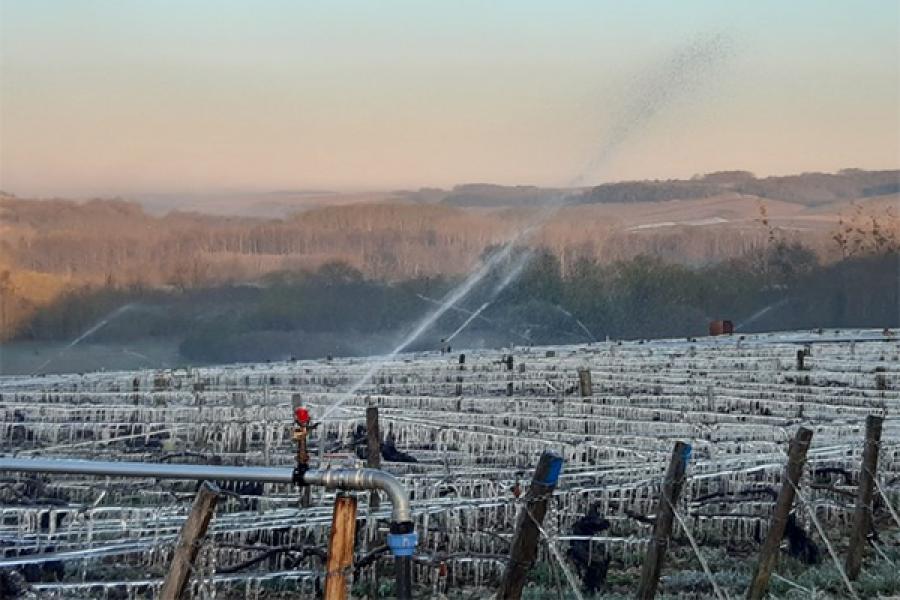The deadliest frost of the 21st century

The French countryside turned into eerie, luminous fields filled with thousands of “candle” heaters flickering in between the endless rows of vines in a bid to save the precious grapes.
The April frost has led to an estimated loss of a third of the country’s wine production with the government pledging to provide €1 billion in financial aid for the farmers and winemakers. The damage varied from region to region as well as the grape variety with Chardonnay and other early budding varieties taking the biggest hit.
‘The frost destroyed 80% of the crop on average, with some parcels at 100%,’ reports Julien Brocard of Domaine Jean-Marc Brocard in Chablis. Albert Bichot of the Domaines Albert Bichot joined him by adding, ‘In Côte de Nuits, Côte de Beaune, Côte Chalonnaise and Mâconnais, the means used (wind turbines, candles, etc.) unfortunately did not give the expected results, as the temperatures were too low.’ In the frame of the winery’s organic and sustainable viticulture approach, they constantly look for alternatives that respect the environment and the vine. In anticipation of these freezing nights, their team at Domaine du Pavillon had sprayed apple pectin and zeolite powder (volcanic rock) in their plots of Beaune 1er Cru Clos des Mouches, Meursault 1er Cru Les Charmes and Corton-Charlemagne Grand Cru. In both cases, the main objective was to lower the freezing point of the buds by the sugar contained in pectin or by taking advantage of the water absorption capacity of zeolite, however, even these methods failed.
The cellar master of Louis Roederer, Jean-Baptiste Lécaillon, said that the impact of the frosts had been uneven across the Champagne appellation but overall, the region had been “more lucky” than other areas of France. The neighbouring Burgundy had lost at least half of their vines with Chardonnay being affected much more than Pinot Noir due to its early budding.
Whilst the damage in the Bordeaux area varied greatly, with some vineyards not being affected at all and some losing 50% of their crop, the rest of South of France has been drastically affected. The Inter Rhône trade body reported that the whole of the Rhône has taken a big hit and predicted that the region was heading for its smallest harvest in 40 years, with some estates losing their entire crop. Languedoc and Gascony reported very similar losses.
Effects of frost on grape vines
A Master of Wine, Anne Krebiehl, writes, “Spring frosts can be devastating. During winter, vines are dormant. They are frost-resistant and can easily survive temperatures as low as -15°C. However, the situation changes dramatically once buds have sent out their first green shoots.” She continues to explain that buds and shoots contain water and when they freeze, it bursts their delicate cell walls. Even if it’s warmer, a few critically cold minutes can destroy an entire crop. Some plants can recover, but vines can’t and their secondary shoots are never as fruitful.
Protecting the vineyards
“The main frost-fighting methods rely on either producing heat or recirculating warm air”, says Brad Greatrix of Nyetimber, a sparkling wine producer in England. Therefore the practice of endless rows of “candle” heaters to produce heat as well as create a protective layer of smoke against the frost used by the French and other European winemakers. Helicopters are also used for air displacement – the pilot finds the inversion layer and hovers around just under it, forcing warm air to circulate back down to the ground, keeping the frost at bay. A less common practice in Europe, although it was used during the April frosts in France including St-Émilion and Pomerol as well as some parts of Champagne and Burgundy.
More modern ways of fighting frost utilised in places like New Zealand, which expects spring frosts every year, include using temperature sensors in the vineyards alongside helicopters and water sprinklers. These sprinklers exploit the latent heat developed through freezing. Water is sprayed over the vines, which freezes in a clear film around the newly formed shoots. In the frosty air, this change from liquid to solid releases heat and protects the shoot. Encrusted in ice, the shoot is safe.
The Kiwi winegrowers weren’t spared either. Along with cooler spring weather, the frost has led to a “significantly smaller vintage” for 2021, New Zealand Winegrowers has said. Despite the bad news, the body is predicting exceptional quality this year after having inspected the remaining vines.
͠
Everyone here at Weavers would like to take this opportunity to express our support to all the wine producers in France and the rest of Europe at this difficult time. We’ll continue to do business with the affected countries and look forward to welcoming the small, yet resilient vintages of 2021.
